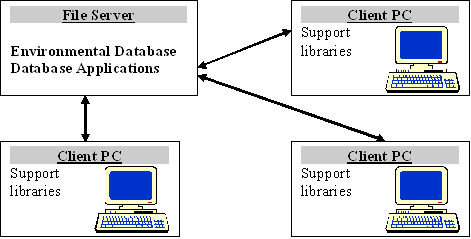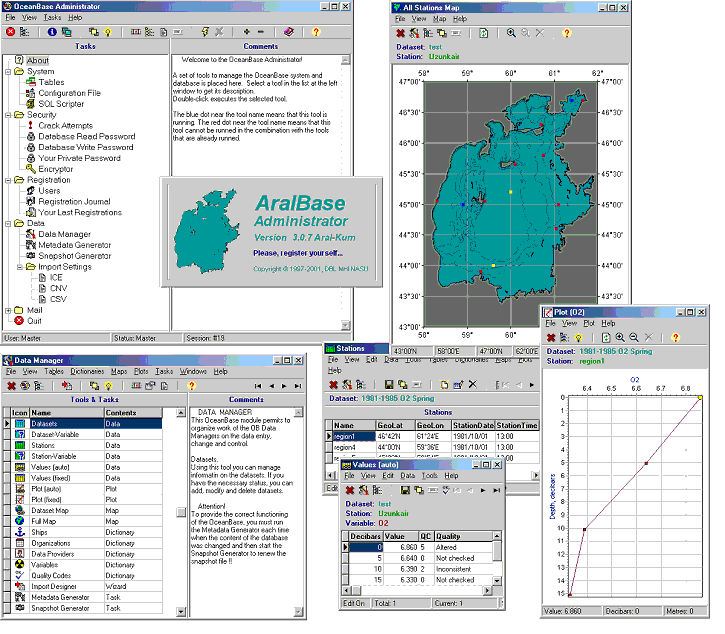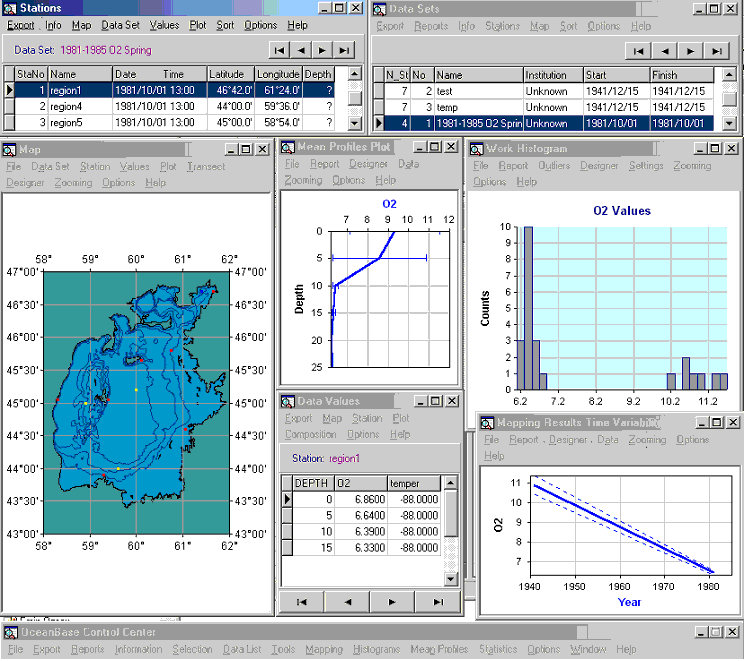
Contact person: Vladyslav Lyubartsev
For many purposes, for example, for the Integrated Coastal Area Management or for creation of the regional historical environmental databases, it is necessary to use large sets of interdisciplinary data of the marine and coastal environment that can contain a lot of variables from different sources and with different structure (oceanographic, meteorological, biological, etc.). Moreover, the most interesting scientific results can be obtained at the boundaries between different disciplines.
However, it is a very complicated task to combine these multidiscipline data sets, to verify them, and to provide the possibility to analyze them jointly. The industry standard database management systems (DBMS) are not enough suitable to process such combined data sets and to perform this task efficiently.
The work to address this task has been conducted at the Database Laboratory of the Marine Hydrophysical Institute (MHI) since 1989. As a result of this work, some special marine database management systems were developed at MHI to fulfill the multipurpose multidiscipline management of such data using the Windows platform [1-3]. The main objective of these systems is to provide for easy, quick and effective work with marine environmental data in oceanography, ecology and environmental management for different scientists and experts: oceanographers, biologists, chemists, ecologists. These systems are also used for the calibration and interpretation of the remote sensing data and images.
Special unique database management and processing system (AralBase) have been developed to work with the large sets of multivariable interdisciplinary oceanographic and environmental data.
It works under Windows 95/98/NT/2000 as a Local Area Network (LAN) application, has effective Administrator and Data Manager modules, and can be used simultaneously by several users.
The structure of the database management in the AralBase system is presented on Fig.1 and LAN possibility for the Database exploitation are presented on the Fig. 2.

Figure 1. Database Management Structure in the AralBase.

Figure 2. AralBase in LAN.
AralBase works with its own database. It is relational database in Borland® Paradox™ format. To avoid unauthorised access, database files are protected with the passwords and they are not accessible through the Paradox or any other software.
All collected data are grouped into the data sets. A data set is usually a set of stations. It is described by its start and end date, has a name, and belongs to an organisation. Usually data set contains data of a research vessel cruise. Division of data to data sets and stations is arbitrary at all and is determined by data providers. Generally speaking, data set may not belong to only one organisation; for example, it can be a joint cruise. Data provider can differ from the organisation. For example, it can be a department or a scientist, or a data centre.
Station is a point located in space and time where some oceanographic environmental measurements were carried out. It is characterised by its name, date and time, geographic co-ordinates, and water depth, and contains at least one data profile containing at least one value. Name is a text string containing not more than 20 characters. Hour, minutes and water depth may be unknown. A station can belong to only one data set.
The initial list of variables (names, full names, formats, and units) was created by the AralBase developers and can be extended by the Administrator and Data Managers.
Each data value is supplied with the quality flag. We had chosen the scheme employed for data reported in real-time by GTSPP [4]. The main advantage of this scheme is its universality and possibility to be applied to any type of data loaded into the database. It uses one character field with the following interpretation:
AralBase is a special database application with the expanded functionality designed to explore large multidisciplinary oceanographic environmental data sets. It provides many possibilities for data loading, selection, access, processing, analysis, preview, and export.
The main task of the AralBase is oceanographic environmental data access. There are some similar commercial applications to accomplish this task, but this system makes it better due to its specialisation, rich functionality and high efficiency. The most valuable feature of AralBase, is the integration of many service tools that allow to the user to carry out almost all data processing without any additional software.
The AralBase consists of the three main applications:
The AralBase Administrator is the main application of the AralBase and it permits to run all main modules and tasks of the system, except the AralBase Explorer. It is the main instrument of the database administrator. The AralBase Data Manager permits to organise work of the Administrator and the Data Managers on the data entry, editing, and quality control. The AralBase Data Explorer (former AralBase itself) is the main module for the end-users of the system. It provides the possibilities for data selection, access, preview, export, and processing, but it does not give the possibility to change data loaded into the database.
Borland Delphi was used to develop database application. This is one of the most comprehensive development platforms for creation of the PC–based database applications with high performance.
To provide more efficient and secure access to the database, the AralBase has five types of Database users:
The AralBase has been designed to work in the Local Area Network. That is why, it has the security features to prevent unauthorised access to the system and to data, and to track any activity related to the system.
All files (tables) of the database are encrypted. There are two passwords, the same for each table: master and secondary passwords. The master passwords allows to all types of operations on the tables (read, write, restructures, etc.). The secondary password provides read operation on all tables and write operations on tables related to the user registration. These two passwords are encrypted also and stored in the AralBase configuration file. So, it is impossible to read any information from the database without AralBase software and passwords. Two passwords are used to provide additional protection of the database and give flexibility to Administrator in the database security management. Common user opens the database with an auxiliary password and he/she can change only registration tables, not the tables containing real data.
All users have their own private passwords. This password is necessary to register and run the AralBase software. Moreover, it is used to track their activity, so all serious actions are tracked and authorised.
The Data Managers can create, edit and delete records in the database tables. Almost all records keep information on their creation and modification. The only Data Manager, who entered the data, is permitted to modify or delete them. Only the Administrator can change this reference. By default, the Data Manager who created the record is responsible for its content.
Administrator maintains the list of all users. Data Managers and Users cannot change any registration information.
The AralBase has a customizing user-friendly multi-windows interface. An user can create his own desktops, open and arrange as many windows as he/she needs. All settings can be stored in the configuration files to create task-oriented desktops for the routine tasks. Data, information, and graphics in different windows are cross-linked and synchronized. Main features of the system user interface are as follows:

Figure 3. Example of the Data Administrator desktop.

Figure 4. Example of the Data Explorer desktop.
The AralBase system is very flexible and can be used in any environmental and oceanographic project or institution dealing with the water environment (ocean, lakes, rivers).